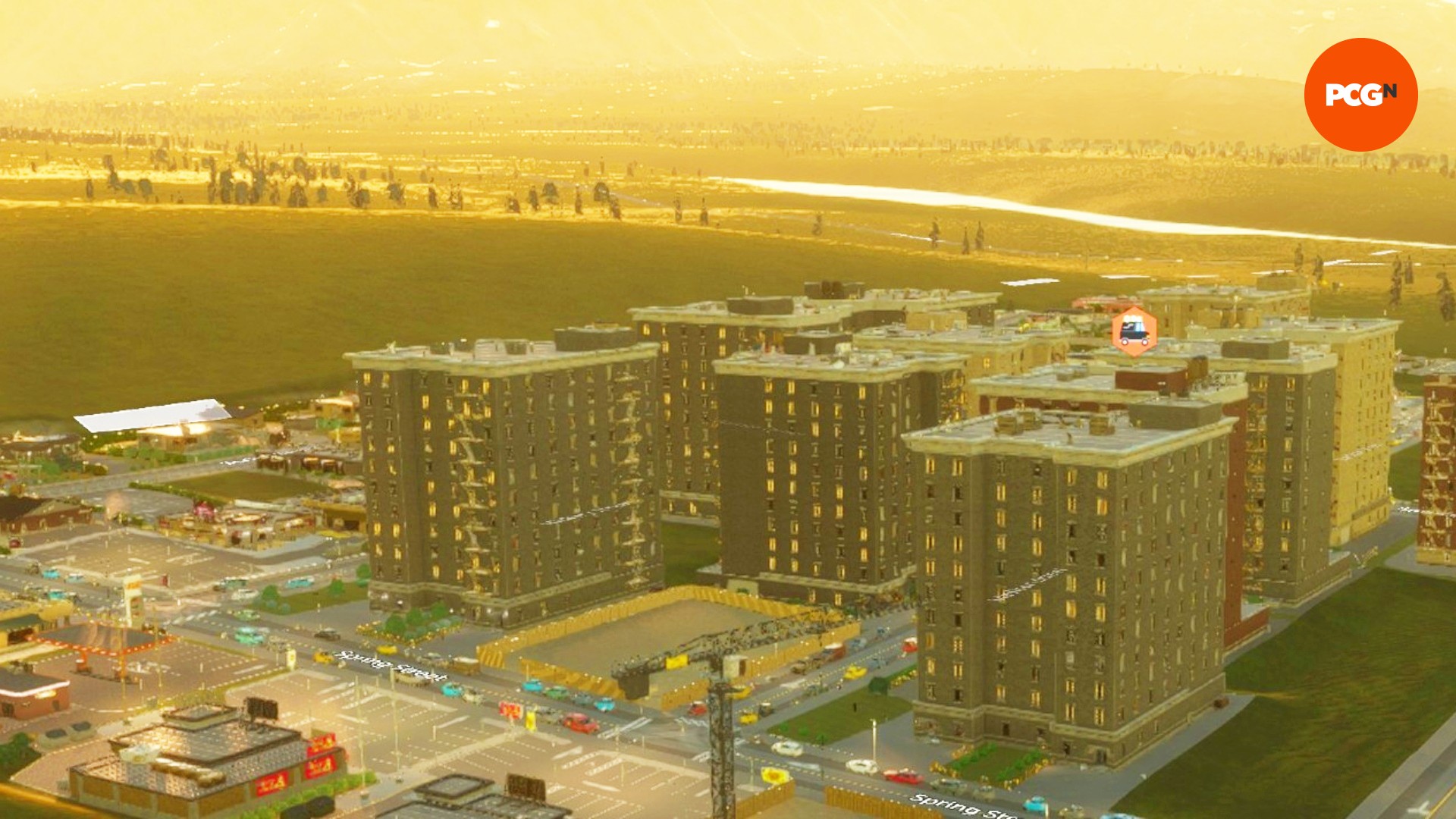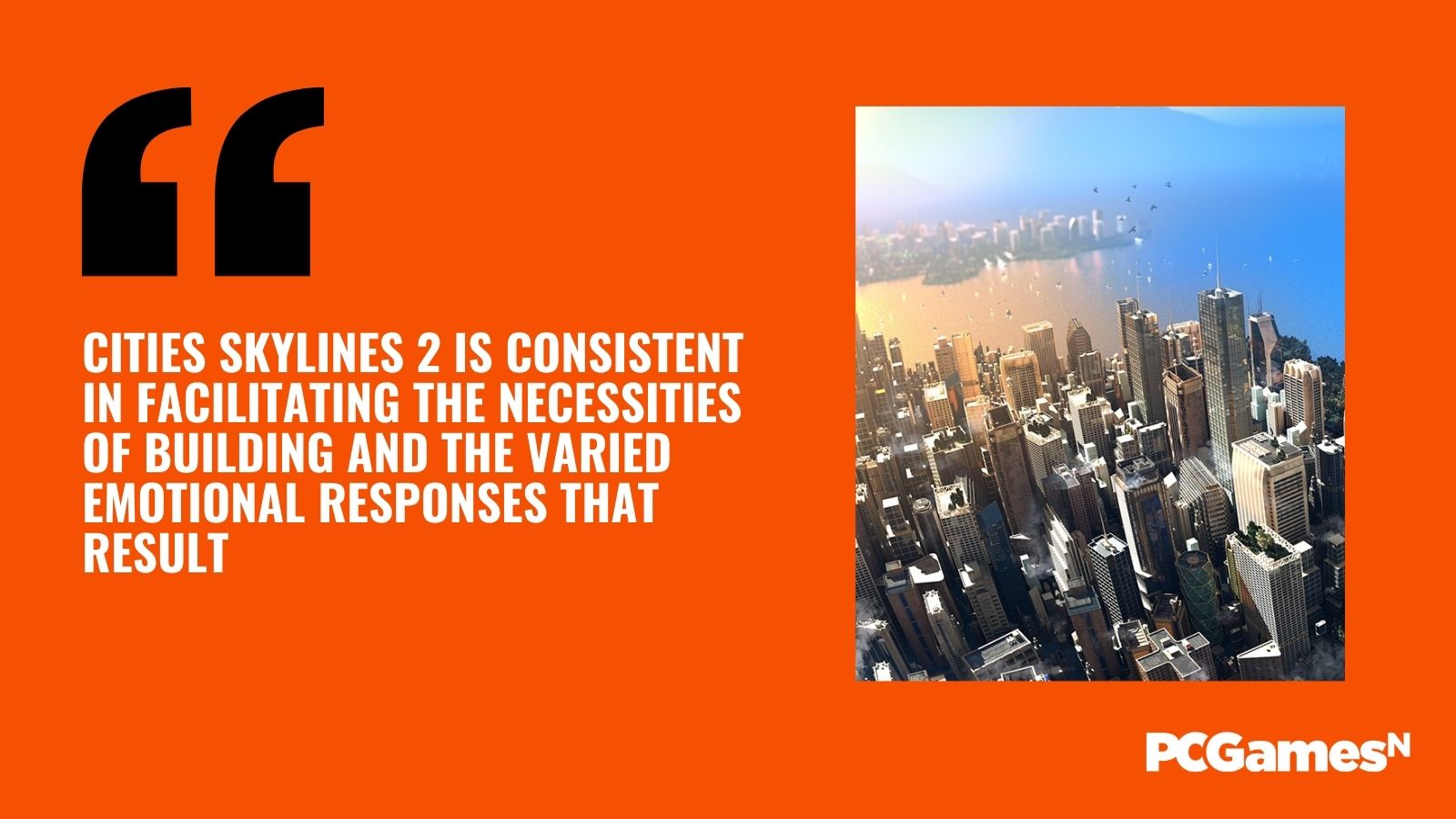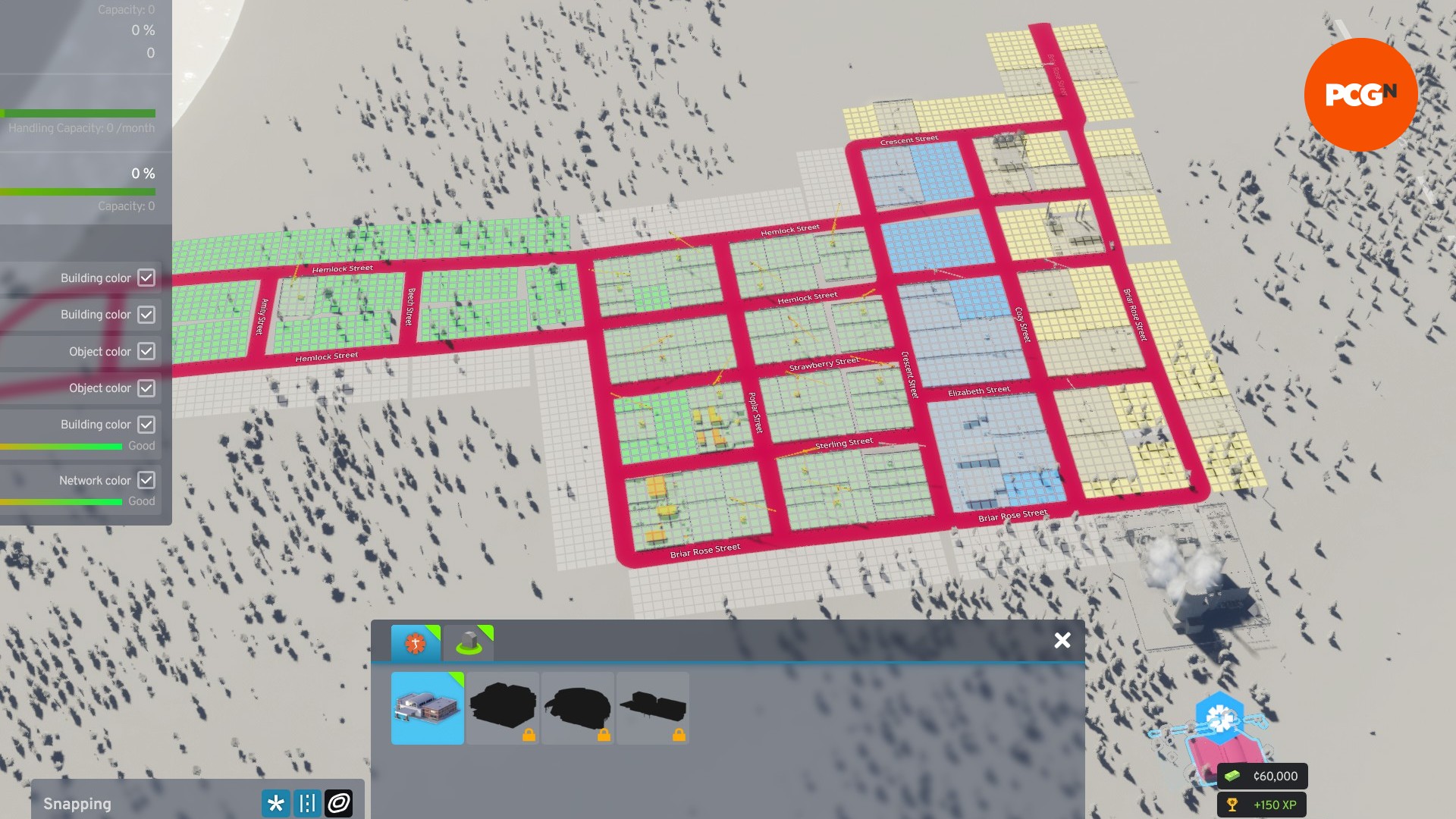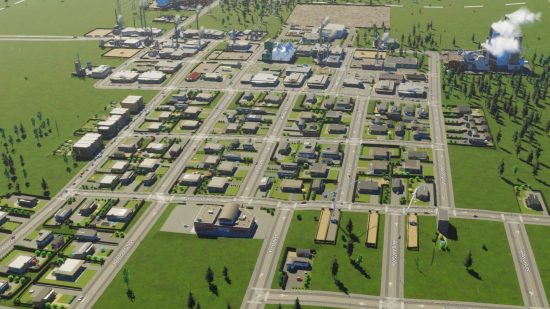Our Verdict
Intricate, intuitive, and ambitious, Cities Skylines 2 successfully integrates all the major improvements that players might have wanted. Something personal is lost in its larger scale, while performance problems spoil the beauty, but this could one day become the superior city building game.
Cities Skylines 2 is a surprisingly emotional game. What appears to be an completely cerebral, fastidiously detailed planning simulator, where success is measured against your ability to efficiently position roads, buildings, and power lines, becomes a rare combination of warm, parochial pleasure and extreme stress. Within a single sitting – even inside a contained, 30-minute playing window – you’ll experience a peaceful, restorative sense of gratification, and then something bordering on supreme frustration and rage.
You build a new primary school, successfully connect it to your road network, and increase the education budget – look at you, the benevolent city planner, and all your contented citizens. And then the electricity grid will fail, the landfills will overflow, and traffic will back up during the morning and evening commutes. The fulfillment from a successful project in Cities Skylines 2 is genuine, sincere – there are no cheap thrills. And then the game tries to choke you with the awful realities of municipal power.
The Cities Skylines 2 release date has been a long time coming. A full eight years since the original city building game, CS2 feels like the culmination of both Colossal Order and the Cities Skylines community’s collective aspirations. Between the new highway ramps and electricity systems, the customizable landfill tools and the reworked economy, CO is attempting to integrate features that were previously only accessible via mods into the Cities Skylines 2 base game.

In some cases, the effects are impressive, and the new tools come as a relief. The instant grid option for roads, for example, which allows you to paint and place square city blocks with one click, rather than laboriously draw them out yourself, is a superb time saver. Likewise, the option to build extensions and upgrades on existing service outlets, like hospitals and police stations, rather than having to find space for more and more copies of the same building. Scaling your city is also much easier now. You can buy more tiles more quickly, have access to a greater amount of funds from the beginning via in-game government subsidies, and roads are integrated with power and sewer lines, so you don’t have to create all three separately.
At the same time, Cities Skylines 2 tries to tamper and pace your progress with more in-depth milestones. Every time you reach a new threshold, either through creating a certain number of buildings, or just raw population growth, you graduate to a new city level, beginning at ‘small village’ and ending at ‘megapolis.’ The development points system lets you choose what advancements, upgrades, and new service types you want to unlock – at the beginning, you might pile your points into basics like healthcare, before letting your imagination take over and pioneering through the transport branch so you can build a space center. There’s effort on behalf of Colossal Order to moderate Cities Skylines 2’s competing sensibilities.
This is a huge, intricately detailed toolset that lets you build bigger creations quicker and with more ease than Cities Skylines 1, by far. The game also tries to guide you in and make sure you don’t become lost in its complexity. Considering what Cities Skylines 2 is trying to achieve – the depth and breadth of its simulation, and the extent of its mechanics – the game is impressively graceful. Most of the building tools are flexible and intuitive – the challenge, quite rightly, is not using the equipment, but having a practical and imaginative vision for a city that you also possess the patience to create.

This isn’t always true, however. The system for outlining specialized industrialized areas feels unnecessarily obtuse, and Cities Skylines 2 could still do a better job of explaining how to create and designate public transport routes. Thanks to a variety of systems, like the overlays that illustrate the best locations for residential zones, the heat maps for your road network, and the drop-down that shows precisely what’s affecting citizen happiness, Cities Skylines 2 is consistent in facilitating the necessities of building and the varied emotional responses that result. It is, for the majority of the time, and like the developer said it would be, complex without being convoluted, intricate without being intimidating.
But there are two problems that prevent the sequel – as it exists at launch – from surpassing the original. First, its aspirations towards bigger Cities Skylines 2 maps, bigger cities, and an overall grander scale create an issue that commonly affects strategy games, whereby you quickly lose a valuable, personal interest in what you’re building. In the original Cities Skylines, the first several hours are spent with a relatively small, highly personalized building project to which you feel intimately connected. Everything in CS1, at least for a vast portion of each game, feels close to you, like you’re lovingly and painstakingly creating a perfect model railway or ship in a bottle, where every contour betrays a personal anecdote. That one road you made sure was just right. That residential district that you zoned perfectly, in relation to the schools and hospitals.

Of course, you later graduate to the boomtowns, the multi-district cities, the megapolis, but the early game at least forges a bond between you and every street, every decision. In Cities Skylines 2, you can buy dozens of tiles within the first hour, and the subsidies give you enough cash to create sprawling, highway-connected urban centers almost from the start. This creates a baggy and dispassionate midgame when you’re beyond the initial stages of careful, affectionate planning, but nowhere near the point that you can stand back and marvel at your final, self-sustaining masterpiece. With each new road, zone, legislation, and so on, your decisions feel like they matter less – like you’re idly inputting a move just to keep the game alive, rather than truly giving attention and care to the nuances of your simulated city.
The original game also has this issue, but it doesn’t manifest until much later, when you’ve had more opportunity to cultivate a relationship to what you’re building, whereas Cities Skylines 2 pushes the scale and pushes it early, so it isn’t long until you stop being the considerate, devoted model builder, and become the indifferent, efficient inputter of clicks.

The second problem is performance. Paradox has admitted already that Cities Skylines 2 does not meet its own internal targets in this regard, and even on a quality rig that comfortably and capably runs the likes of Baldur’s Gate 3, Starfield, and the recent Call of Duty Modern Warfare 3 beta, Cities Skylines 2 has considerable problems. Loading times are inconsistent. Zooming in and out of your city creates freezes and wait times. Detail levels drop. Running CS2 on the lowest preset solves many of these issues, but for a game where panoramic, architectural, and scenic splendor are supposed to reign – where one of the principal joys is marveling at the beauty and intricacy of what you have created – it feels like this is not really possible in its current form.
Naturally, we’ve got to think about the long-term here. Between incoming updates, Cities Skylines 2 DLC, Cities Skylines 2 mods, and so on – in fact, even in the depth of its own mechanics – this is a game we’re expected to play, and which the creators are planning to perfect, for years to come. Cities Skylines 2’s performance will, surely, get better. But at the moment, there are times when it borders on being too sluggish and unpredictable to enjoy. Eight years since it first launched, the original Cities Skylines is now a swift, graceful, and well-balanced city builder that marries complexity and accessibility. As it stands, Cities Skylines 2 is below that high watermark – but the foundations are perhaps stronger, and it could, one day, be a better game than its predecessor.
